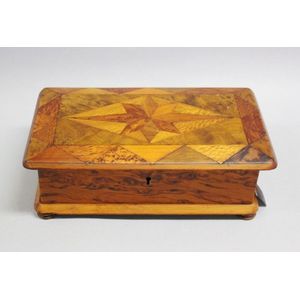Japanese Gold Lacquer Document Box with Horse Decoration
Gold lacquer document box, Japanese 19th century prancing horses decorated on a nashiji (sprinkled) background, eyes are inlaid with black coral and tortoise shell, interior of box cover is decorated with two cranes in flight above pine, prunus and bamboo trees beside a stream, lacquer in deep relief work (takamaki-e and hiramaki-e), original receipts available. Height 17 cm. Length 37 cm. Width 29 cm. Labels 'Document boxes of this size and quality of workmanship are rare and seldom seen. The document box, because of important messages carried inside, are among the rarest and most important subjects in Japanese lacquer Art' Exhibited ex: Ashkenazie & Company. Private Collection, Sydney
You must be a subscriber, and be logged in to view price and dealer details.
Subscribe Now to view actual auction price for this item
When you subscribe, you have the option of setting the currency in which to display prices to $Au, $US, $NZ or Stg.
This item has been sold, and the description, image and price are for reference purposes only.
- Lacquered Lacquerware - Lacquer is a clear or coloured resin that is obtained from the sap of several species of trees in the genus Rhus, particularly the Rhus verniciflua tree, which is native to China and Japan. The resin is harvested by making incisions in the tree bark and collecting the sap that oozes out.
The sap is then processed and refined through a series of steps, which may include filtration, heating, and chemical treatments. The resulting lacquer is a highly durable and glossy material that is used as a finish for furniture, musical instruments, and other objects.
Lacquer has been used for thousands of years in Asia, where it is valued for its beauty and durability. It is applied in multiple thin layers, with each layer being allowed to dry and harden before the next one is added. The process can take several weeks or even months to complete, but the resulting finish is incredibly hard, glossy, and resistant to scratches and wear.
The lacquer derived from the resin of the Rhus tree has been used for decoration of furniture in several countries in Asia, particularly China, Japan, Korea, and Vietnam. These countries have rich traditions of using lacquer for furniture decoration and have developed unique techniques and styles of lacquer work.
In China, lacquer has been used for furniture decoration for over 2,000 years, and it became a major art form during the Ming (1368-1644) and Qing (1644-1912) dynasties. Chinese lacquerware is known for its intricate carving, painting, and inlay work, as well as its use of bold colours and designs. Lacquer was used to decorate furniture such as cabinets, screens, and chairs.
In Japan, lacquer has been used for furniture decoration for over 1,000 years. Japanese lacquerware is characterized by its simplicity and elegance, and it often incorporates natural materials such as wood, bamboo, and shells. Lacquer was used to decorate furniture such as chests, cabinets, and trays.
In Korea, lacquer has been used for furniture decoration for over a thousand years. Korean lacquerware is known for its restrained and understated beauty, and it often features delicate patterns and designs that are achieved through careful layering and carving. Lacquer was used to decorate furniture such as cabinets, chests, and screens.
In Vietnam, lacquer has been used for furniture decoration for over 2,000 years. Vietnamese lacquerware is known for its vibrant colours and intricate designs, and it often features scenes from daily life, nature, and mythology - Tortoiseshell - Tortoiseshell is a translucent material that comes from the horny carapace of a certain types of turtles, including the hawksbill turtle. It is often therefore mounted on a colour underground - often red - or inlaid with gold or silver thread, as seen in Boulle furniture.
The texture and colour nuances of the material are extremely important. Heated tortoiseshell can easily be formed into various shapes. Like other natural materials, tortoiseshell becomes more beautiful with use. In a time before plastic, tortoiseshell was widely used for small objects such as combs and powder compacts.
In 1973, the trade of tortoiseshell worldwide was banned under CITES (The Convention on International Trade in Endangered Species). Prior to importing or exporting items containing tortoiseshell a CITES permit must be obtained. Tortoiseshell items cannot be traded on Ebay.
"Faux tortoiseshell", another case of man initiating nature, is made from old-style plastics such as celluloid and cellulos and is coloured with red, yellow and brown spots to imitate the genuine article. It is commonly used in glasses frames, musical instruments and costume jewellery.
This item has been included into following indexes:
- oriental objects - boxes 1,766
Visually similar items

Sold by
in
for
You can display prices in $Au, $US, $NZ or Stg.

1oz. fine gold nuggets, in small envelope, detail to the exterior '1oz. fine gold'. Parcel weight 32.92gms.
Sold by
in
for
You can display prices in $Au, $US, $NZ or Stg.

Attributed to William Norrie (New Zealand ) specimen wood jewellery box, circa 1890s, approx 10 cm high, 31 cm wide, 20 cm deep
Sold by
in
for
You can display prices in $Au, $US, $NZ or Stg.

RAF Station Castel World War II era photo album, by L. A. C. Schembri (?), includes pictures of Nazi wreckage, 16 x 24 cm
Sold by
in
for
You can display prices in $Au, $US, $NZ or Stg.
